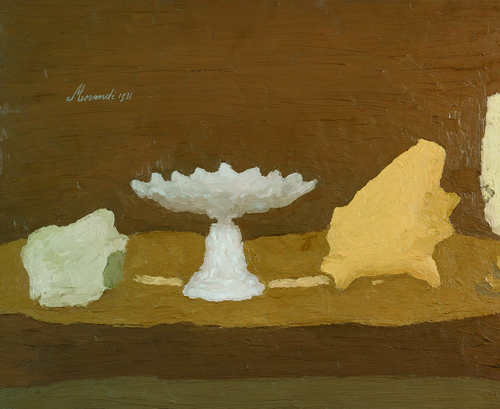Giorgio Morandi at CIMA, New York Residency January 2016
April 14, 2016
Mercedeh Mirshamsi, Cohort ’14
Giorgio Morandi is an Italian painter who was most famous for being the greatest master of Natura Morta (Still Life) of the 20th century. During the New York Residency of 2016, we had an opportunity to view some of his still life paintings, which were on display at CIMA - Center for Italian Modern Art, located in SoHo.
.jpeg)
Morandi got his nickname ‘the monk’, for his reclusive solitary lifestyle, spending most of his time alone in his studio, painting image after image of everyday, mundane objects such as bottles, vases, jars and pitchers. He would spend long hours diligently arranging and rearranging his carefully chosen objects before embarking upon painting them. Once chosen, he would paint those same pieces over and over like a mantra, which gave his art a deep contemplative and meditative quality. It is also worth mentioning that his working method, besides being meditative, could even be viewed as slightly fetishistic, specifically due to its repetitive nature.
Looking at his still life pieces as a spectator, at first glance, it appears as if one is witnessing a painting about simple-looking shapes with a humble naïve feel to them. However, by closer examination, one notices a subtlety, which goes deeper into the realms of so called meta- consciousness. One realizes that one is not simply looking at a painting about simple objects, but rather, something beyond the realms of classical representation.


(Right) Giorgio Morandi, Natura morta (Still Life), 1960 (Vitali 1172). Oil on canvas, 25 x 35 cm. Private collection. © 2015 Artists Rights Society (ARS), New York / SIAE, Rome.
(Left) Giorgio Morandi, Natura morta (Still Life), 1931 (Vitali 164). Oil on canvas, 54 x 64 cm, 21 3/16 x 25 3/16 in. Private collection. © 2015 Artists Rights Society (ARS), New York / SIAE, Rome.
Although Morandi is known for being a “Still Life” painter, it seems as if he was in fact using the very act of “Still Life” painting to attain a deeper level of awareness about life and the very nature of physical reality. His work did not appear to be about the objects he painted. In other words, the repetitive Still Life painting for him seemed to be more of a meditative tool and a vessel in which he travelled deep into the depths of his soul to bring out timelessness, stillness and eloquence. This why the monk is known for being a Metaphysical painter or perhaps even an Artist Philosopher or the “One who has arrived at Suchness” – a Tathāgata.
Morandi, through his engagement of such intense level of repetitive artistic practice, came to a deep philosophical realization about the nature of material existence. Towards the end of his life he said, “There is nothing more surreal, nothing more abstract than reality.” This is a deep reflection on the very essence of our experience as human beings. It is a great demonstration of where our desire and drive for attaining the Real can take us. It always leads us to “suchness” only to show us that “suchness” is not as “such.”
